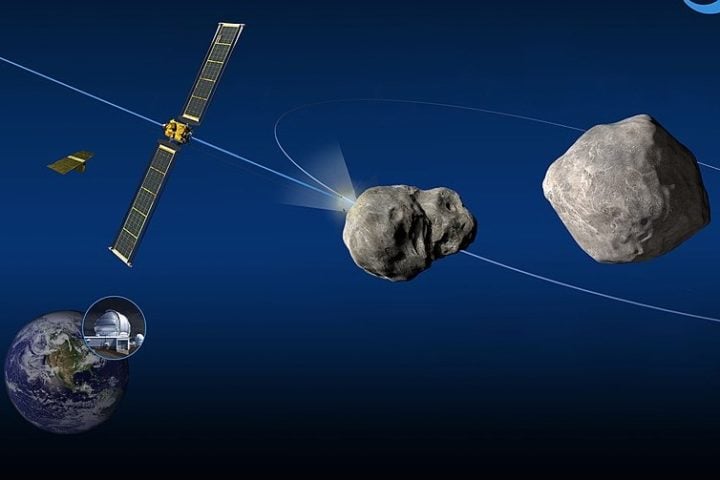NASA’s DART mission crashed a spacecraft into the nearby asteroid Dimorphos to test a possible strategy for deflecting asteroids that are headed for Earth. The test succeeded in knocking Dimorphos slightly off course but also dislodged from its surface 37 boulders that are now moving away from the asteroid.
In September 2022, NASA deliberately slammed a spacecraft into the asteroid Dimorphos to knock it slightly off course. NASA’s objective was to evaluate whether the strategy could be used to protect Earth in the event that an asteroid was headed toward our planet.

Schematic of the DART mission. NASA/Johns Hopkins Applied Physics Lab via Wikipedia, Public Domain
A new study led by UCLA astronomer David Jewitt found that the collision had an unintended consequence: It launched a cloud of boulders from its surface. And, as the paper notes, smaller rocks flying off into space could create their own problems.
“The boulder swarm is like a cloud of shrapnel expanding from a hand grenade,” said Jewitt, lead author of the study and a UCLA professor of earth and planetary sciences. “Because those big boulders basically share the speed of the targeted asteroid, they’re capable of doing their own damage.”
Jewitt said that given the high speed of a typical impact, a 15-foot boulder hitting Earth would deliver as much energy as the atomic bomb that was dropped on Hiroshima.

A Hubble Space Telescope image of the asteroid Dimorphos surrounded by boulders (tiny bright dots, circled) that were knocked off of the asteroid’s surface by NASA’s DART mission. Image credit: NASA, ESL, David Jewitt/UCLA
Fortunately, neither Dimorphos nor the boulder swarm have ever posed any danger to Earth.
NASA chose Dimorphos because it was about 6 million miles from Earth and measured just 581 feet across — close enough to be of interest and small enough, engineers reasoned, that the half-ton Double Asteroid Redirection Test, or DART, planetary defense spacecraft would be able to change the asteroid’s trajectory.
When it hurtled into Dimorphos at 13,000 miles per hour, DART slowed Dimorphos’ orbit around its twin asteroid, Didymos, by a few millimeters per second. But, according to images taken by NASA’s Hubble Space Telescope, the collision also shook off 37 boulders, each measuring from 3 to 22 feet across.
None of the boulders is on a course to hit Earth, but if rubble from a future asteroid deflection were to reach our planet, Jewitt said, they’d hit at the same speed the asteroid was traveling — fast enough to cause tremendous damage.

DART infographic. Image credit: NASA/Johns Hopkins APL
The research, published in the Astrophysical Journal Letters, found that the rocks were likely knocked off the surface by the shock of the impact.
A close-up photograph taken by DART just two seconds before the collision shows a similar number of boulders sitting on the asteroid’s surface — and of similar sizes and shapes — to the ones that were imaged by the Hubble telescope.
The boulders that the scientists studied, among the faintest objects ever seen within the solar system, are observable in detail thanks to the powerful Hubble telescope.
“If we follow the boulders in future Hubble observations, we may have enough data to pin down the boulders’ precise trajectories,” Jewitt said. “And then we’ll see in which directions they were launched from the surface and figure out exactly how they were ejected.”

Asteroid moonlet Dimorphos as seen by the DART spacecraft 11 seconds before impact. DART’s on board DRACO imager captured this image from a distance of 42 miles (68 kilometers). This image was the last to contain all of Dimorphos in the field of view. Dimorphos is roughly 525 feet (160 meters) in length. Dimorphos’ north is toward the top of the image. Credits: NASA/Johns Hopkins APL
The European Space Agency’s HERA spacecraft will have an opportunity to collect more data about the boulders when it returns to Dimorphos in 2026 to study DART’s results in more detail. Findings from that mission wil.l inform future planetary defense strategies and technologies, Jewitt said.
Source: UCLA

